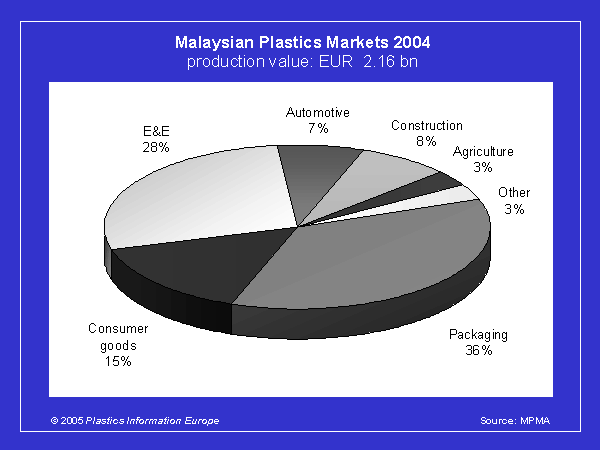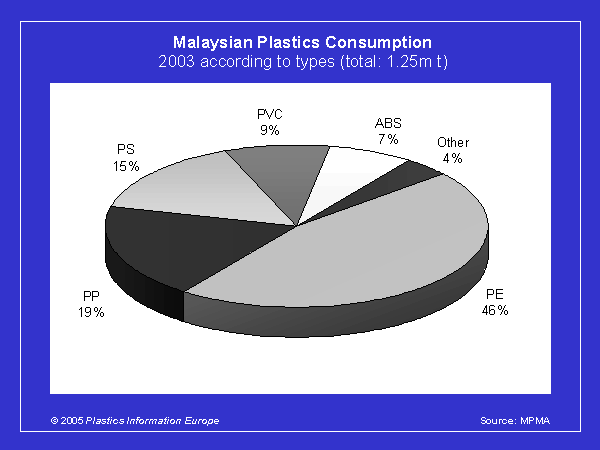MALAYSIA
Plastics processing industry in transition / Increased competition from low-wage countries calls for more advanced technology / Polymer consumption 1.4m t / Growth in automotive, construction
Following the unexpected business slump in the Malaysian plastics processing industry in 2001, 2002 and 2003, sales in 2004 increased significantly by 22% to MYR 11.5 bn (about EUR 2.4 bn). According to the Malaysian Plastics Manufacturers Association (MPMA, Selangor / Malaysia; www.mpma.org.my), this growth spurt will also be sustained in 2005. Its projection is based mainly on lively demand from non-domestic markets. The country´s core export products are sheet and film (29.8%) as well as carrier bags (23.3%). For 2005, MPMA expects an additional 8% growth in exports to MYR 12.4 bn.
Despite an extensive domestic production, Malaysia continues to be a net importer of plastics. While about half of the country´s annual consumption of 1.4m t of (mostly commodity) plastics) is exported, 550,000 t are imported, with engineering plastics representing about 50%. In 2004, Malaysia consumed 1.5m t (1.25m t in 2003) of plastics, 60% of which were polyolefins. With a population of 21m, the country has a per capita consumption of 55 kg, on a par with some EU countries that have low consumption. MPMA estimates that use of plastics could reach 2.2m t by 2010. Currently, the processing sector is comprised of nearly 1,400 mostly small to medium-sized, often family-owned companies with around 90,000 employees
The industry´s largest market is packaging (36%), followed by E+E components (28%), consumer goods (15%), construction elements (8%) and automotive engineering (7%). In 2004, the value of exported finished plastic products amounted to MYR 5.6 bn (EUR 1.2 bn), up 23% on 2003. The main driving force for this upswing comes from the production of carrier bags, bottles and containers (38%) as well as sheet and film (29%).
Despite an extensive domestic production, Malaysia continues to be a net importer of plastics. While about half of the country´s annual consumption of 1.4m t of (mostly commodity) plastics) is exported, 550,000 t are imported, with engineering plastics representing about 50%. In 2004, Malaysia consumed 1.5m t (1.25m t in 2003) of plastics, 60% of which were polyolefins. With a population of 21m, the country has a per capita consumption of 55 kg, on a par with some EU countries that have low consumption. MPMA estimates that use of plastics could reach 2.2m t by 2010. Currently, the processing sector is comprised of nearly 1,400 mostly small to medium-sized, often family-owned companies with around 90,000 employees
The industry´s largest market is packaging (36%), followed by E+E components (28%), consumer goods (15%), construction elements (8%) and automotive engineering (7%). In 2004, the value of exported finished plastic products amounted to MYR 5.6 bn (EUR 1.2 bn), up 23% on 2003. The main driving force for this upswing comes from the production of carrier bags, bottles and containers (38%) as well as sheet and film (29%).
 | |
Free trade zone leads to low-wage competition
Between 1990 and 2000, Malaysia´s plastics processing industry enjoyed annual growth rates of 20-25%. However, this success was not to last. In the wake of the establishment of the Asian Free Trade Area (Afta), and the subsequent competition from neighbouring countries with lower wages, business took a turn for the worse. The fact that the new trade agreement involved the reduction of import tax from 20% to 5% affected the packaging industry, the consumer goods segment and, most severely, the E+E industry. Manufacturers of television sets, for example, relocated their facilities to low-wage countries.
As a result, MPMA recognised that the plastics processing industry needed to focus on premium quality products. This in turn necessitates investment in new technology as well as technically advanced machinery to maintain a competitive edge and move into new markets. At the same time, there is a shortage of training positions for qualified personnel. In the past, topics such as environmental protection and work safety had been at the bottom of the list. Recently, however, the association released a new safety guide especially for the plastics processing industry.
 | |
Automotive and construction main growth segments
Malaysia´s automotive and construction industries are experiencing slight growth. At the end of 2003, Proton, the country´s largest vehicle manufacturer with a capacity of about 500,000 cars per year, opened a new plant, and truck specialist Perodua followed suit in 2004. Due to increased building activity, the construction industry has benefited from a rising demand for pipes made from PVC and PE since 2003. In 2004, around 90,000 t of pipes were produced. For the coming years, MPMA estimates a 5% growth rate in these two segments, which are perceived as one of the country´s main economic driving forces.
28.07.2005 Plasteurope.com [202975]
Published on 28.07.2005

 German version of this article...
German version of this article...